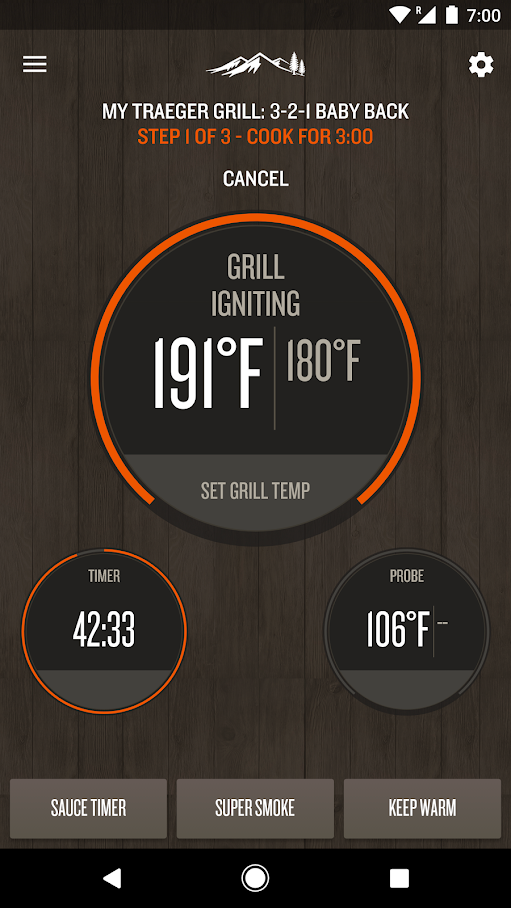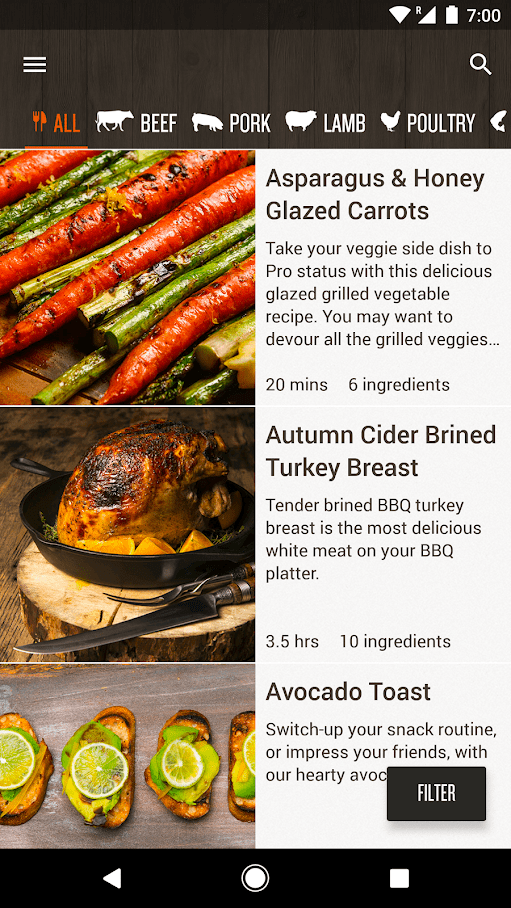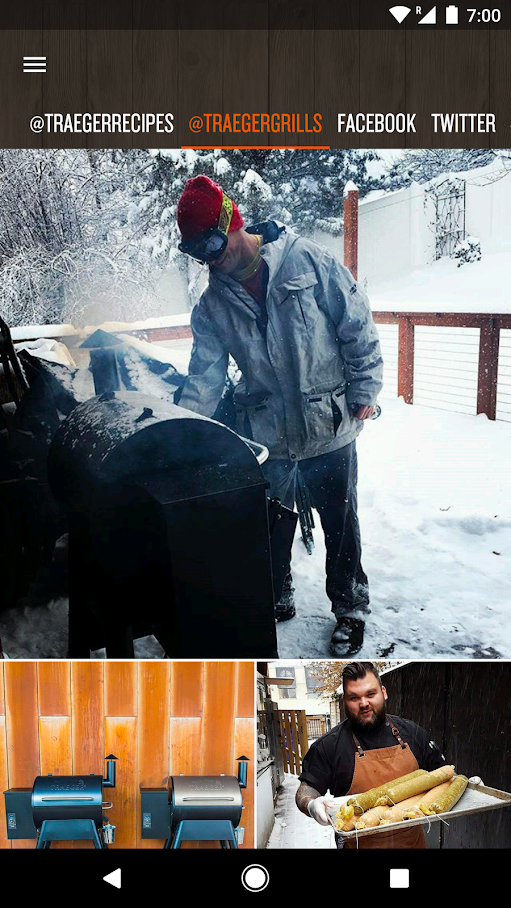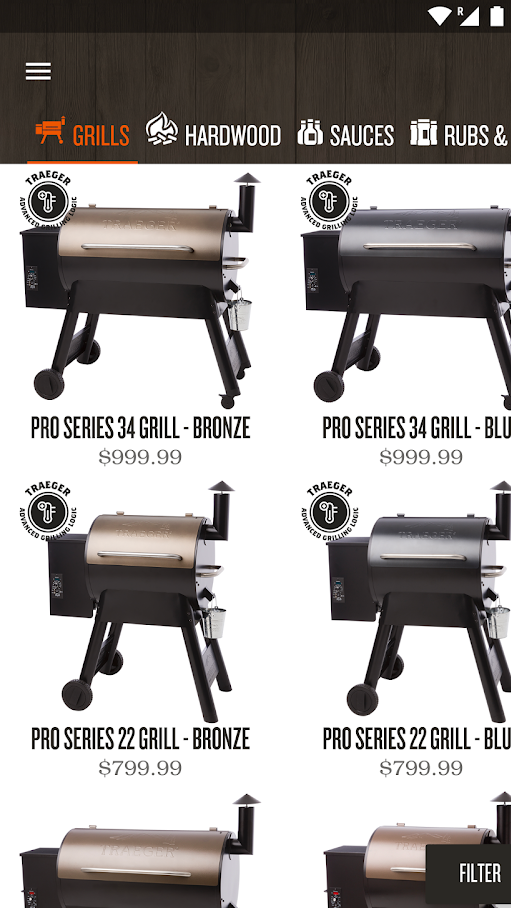“The Traeger Timberline 850 (mostly) delivers on its promise of making grilling all but effortless.”
- Large size means it can grill lots at once
- Lots of recipe options in app
- Made of sturdy materials
- Provides great smoky flavor
- Expensive
- Buggy app
After having a propane grill catch fire on the deck of his home in the mid-1980s, Joe Traeger retreated to his barn in Mount Angel, Oregon, and designed the very first wood pellet grill. In the more than 30 years since, the Traeger brand has become synonymous with top-of-the-line grills and smokers that use a slow-cooking process to produce mouthwatering meats and poultry.
Innovation remains a key focus for the company, which has packed smart technology into the Timberline series of wood-fired electric grills it debuted in 2017. A downloadable app allows the grill to be controlled from anywhere and provides access to thousands of recipes, enabling grilling lovers of all levels of expertise to “set it and forget it,” said Michael Colston, vice president of product development and engineering for Traeger.
Like other Traeger models, the Timberline grills “leverage pellets to deliver more flavor into the food than charcoal or propane,” Colston said, adding that the new grills’ smart tech “takes things to the next level, [allowing them] to be controlled from anywhere in the world.”
We spent a couple months with the Traeger Timberline 850 Wi-Fi-controlled Wood Pellet Grill ($1,700) to see for ourselves if it delivers on those claims, as well as how it stacks up against other smokers and charcoal and propane models.
Out of the box
This is no lightweight charcoal grill – the Timberline 850 is a bruiser, and you’re going to need help setting it up. Rather than risk ending up in traction by trying to lift this hefty 213-pound grill out of the box, instead peel away the cardboard box it comes in. Next, open the grill door and remove all the boxes and parts stored in the grilling chamber during shipping, including the grills.
Since we wanted to set the smoker up on a raised outdoor deck on one of our test homes, we needed to get the legless main section up a flight of steps. This was a definitely a two-man job that we were barely able to pull off.
Assembling the grill was a relative breeze. Again, you’ll need another person to help you lay the main part of the grill on its back so you can attach the legs. Pro tip: Stick a piece of Styrofoam or the sturdier cardboard packaging from the box underneath the main section of the grill to provide a better angle to attach the legs.
The four legs and the two brackets that go between the legs require a total of 12 screws to attach, which shouldn’t take long at all. Once that’s done, you’ll again need to enlist help to stand the grill up and attach a pair of shelves, which are more cumbersome than heavy. Finally, open the grill and unscrew the handle, which is mounted on the inside for shipping. Use the same two holes to attach it on the outside and you’re nearly ready to start grilling.
Getting ready to grill
Now that the grill is put together and upright, there are a couple of preparations to make before it’s time to grill. First, the grease trap must be primed. This entails pouring about a cup of water into the trap. (As you use your grill, the water in the grease trap will slowly be replaced by grease from the drip tray. If smoke comes out of the bottom of the grill, it’s time to add more water to replace what’s evaporated during the cooking process.)
When it came to seasoning the grill, everything went perfectly — until it was time to hit the ignite button.
Next up is seasoning the grill, which allows the pellets to run through the auger for the first time. This is a one-and-done process. Before starting, the grill grates, heat shields, and drip tray must be removed. Now, it’s time to add pellets to the hopper, plug in the grill, and turn it on. Go to the auger menu and pellets will begin to run through the auger and into the firepot. Once a few pellets have reached the fire pot, put the grates, shields, and drip tray back in the grill and initiate the 45-minute preheat cycle. When that’s finished, the grill will be seasoned and ready to use.
When it came to seasoning the grill, everything went perfectly — until it was time to hit the ignite button. Several minutes of pressing the button failed to ignite it. A call to Traeger’s customer service line also proved fruitless. We gave up for the night, disappointed that we wouldn’t be doing any smoking that weekend. Three days later, we tried again — it worked on the first try. Since then, we’ve only had a problem igniting the grill one other time.
Let’s get grilling
The Timberline offers a variety of cooking methods, including using a single temperature, a preset custom cooking option, a custom cook option of your own, or the included probe.
Rather than starting off with a major undertaking like prime rib or a brisket, we dipped our toes into cooking with a simple London broil, which is a cooking method, not a cut of beef. We marinated a two-pound top round steak, then (mostly) followed a recipe from the included Traeger’s Everyday Cookbook. While the recipe recommended a short cooking time of eight to 10 minutes per side at a single temperature of 450 degrees Fahrenheit, we left the meat on the grill a little longer to take it from rare to somewhere between medium rare and medium. The meat quickly reached the desired doneness, thanks to the Traeger’s method of circulating the heat around the meat, which delivers the same temperature and amount of smoke to all three grills.

Now that the smoker was broken in, we moved on to more challenging fare: A prime rib, baby back ribs, and a brisket – all on the same weekend. For the prime rib, we used the temperature probe, which plugs into the smoker’s controller. The probe is then threaded through a grommet that leads into the main cooking chamber and inserted into the meat. It had cooked for about 3.5 hours when the alarm we had set sounded, indicating the meat had reached the desired temperature. The meat was just about perfect, with a medium-rare center and medium-well to well edges.
Next up were a couple racks of baby back ribs. We used Trager’s recipe for Memphis-style ribs, which involves cooking the ribs faster than most other methods sans barbecue sauce. The recipe called for the ribs to cook two to three hours, but the ribs were slightly overcooked after two hours.
One major takeaway from our time with the Timberline smoker was to take the times specified in the recipes with a grain of salt. Checking the temperature of the meat often – either with the probe or a meat thermometer – and cutting into the meat to determine doneness is the best way to ensure the meat is at its most flavorful and juiciest.
One major takeaway as to take the times specified in the recipes with a grain of salt.
We concluded our weekend extravaganza of grilling with a nice-looking brisket. We took the slow-cooking route this time, grilling it at a low and steady 225 degrees F for 18 hours. Unfortunately, due to chef’s error, we left it on maybe an hour too long, resulting in a dry but still tasty and pleasantly smoky piece of meat. The Timberline’s Super Smoke feature gives meat excellent flavor without tasting like it was just pulled out of a three-alarm blaze.
Later, we cooked chicken breasts, skewered veggies, and Korean short ribs on the smoker — all with excellent results. The chicken was juicy and full of flavor, though we did find that it cooked very quickly. The vegetables had a wonderful smoky flavor that you simply won’t get with a propane grill. Finally, the short ribs were absolutely delectable, thanks in large part to the marinade featured in Traeger’s recipe.
Other cooking methods
The Timberline also offers two preset Custom Cooking recipes: Chicken Challenge and Beginner’s Brisket. Once one is selected, you’ll have the following options: Run now, Edit, Delete, or Back to return to the previous menu. If you select Run Now, the smoker will walk you through all the steps including inserting the probe (if applicable) and igniting the grill.
There is also the option to program a total of four custom cooking methods (if you delete the two that come preprogrammed).
Using the app
The Timberline’s WiFire Wi-Fi controller easily allows users to change the temperature of the grill, set timers, and connect with other Traeger owners from your phone via the Traeger app … in theory at least. The smart tech baked into the Timberline smoker is its biggest selling point and is a major reason why it costs so much more than a traditional smoker. Unfortunately, based on our time with it, there still seem to be bugs that need to be worked out.
The app, which looks good and is easy to navigate, also provides access to thousands of recipes.
Downloading the app to a smartphone was the first thing we did upon setting up and seasoning the Timberline 850. Unfortunately, getting the app to sync up with the grill and download a recipe to it was a frustrating experience that took up a ton of time and required a call to Traeger reps for guidance. We were able to view recipes, but were not able to send those recipes to our smoker.
Once we finally got it to work, the result was a couple of perfectly cooked chicken breasts based on the recipe we downloaded: Barbecued Chicken Nachos. But the process to get there needs to be more intuitive and smoother than the one we endured. While Traeger reps say that our experience was an exception to the norm, we can only speak to how it went for us.
When the app was working, the process was simple: Just download the Traeger app to your phone, sync it with the grill, choose a recipe, and download the recipe to the grill. The grill will then walk you through the process of carrying out that recipe. Of course, you need to put the meat in the smoker (sorry, they haven’t invented an app for that yet), but there’s no babysitting the grill after that. The app will alert you when the meat has been in the smoker for the specified amount of time.
For safety reasons, you can’t ignite the grill via the app – that could potentially lead to one expensive butt dial. Other than that, you can do the cooking right from your phone. The app allows you to preheat the grill, set the temperature, and, when using the probe, see when the meat has reached the desired internal temperature.
“The beauty of the Wi-Fi technology is that it frees you up to do things with friends and family,” Colston said. Along those lines, we let the brisket cook overnight without having to worry about getting up during the night to check on it.
The app, which is extremely attractive and a breeze to navigate, also provides access to thousands of recipes that were developed by Traeger’s grilling experts.
Lots of real estate
The 850 in the smoker’s name refers to the cooking capacity of the three tiers of grill – 850 square inches. Simply put, you can fit a ton of food in this baby – up to nine whole chickens or six pork butts. So, if you tend to grill a lot of food at once or often cook for large groups, this model should have you covered. (The Timberline 1300 offers an additional 500 square inches for those whose diets begin and end with barbecue.)
Pellets go a long way
With some of us having never cooked on a pellet grill before, we were curious to see how it compared to cooking with charcoal and propane. What we found is there is no comparison. The pellets infuse a smoky – but not overwhelmingly so – flavor that propane just can’t match. It’s also much less of a hassle than a charcoal grill.
The pellets infuse a smoky – but not overwhelmingly so – flavor that propane just can’t match.
The hopper holds up to 24 pounds of pellets, and we used less than one bag to grill all the food listed above. Traeger offers eight varieties of pellets –alder, apple, cherry, hickory, maple, mesquite, oak, and pecan – and includes recommendations of which to use with each recipe. Each bag costs about $19, but one bag goes a long way.
A couple things to note: we wish that there was an onscreen icon to signal when the Super Smoke mode is on, and the grill comes with a wooden magnetic cutting board, which adheres to the lid of the hopper and comes in handy when you’re cooking up a storm.
Warranty information
The Timberline comes with a generous three-year warranty against defects in material and workmanship under normal use.
Our Take
The Traeger Timberline 850 is packed with tech and useful features, and that is reflected in its $1,700 price tag. This model, as well as its larger sibling, the Traeger Timberline 1300 ($2,000), are not aimed at the casual outdoor cook – they’re for weekend warriors who take their grilling (and their tech) seriously. Unfortunately, that high price tag is a major obstacle for many would-be owners and one of the knocks on this product. Don’t get us wrong – this is a great product that’s worth every penny to the right people, but it’s also definitely a luxury item.
The grill is Traeger’s big swing at a smart product, and it’s more of a hit than a miss despite some issues with its key feature, the app. It’s a sturdy, attractive model that’s easy to set up and a breeze to cook on.
Is there a better alternative?
There are certainly more affordable options out there – and many of them come from Traeger. If you’re in the market for a quality pellet grill and can live without the smart technology, Traeger has models that start as low as $449 –less than a third of what the Timberline 850 costs. Pellet grills are what Traeger does, so you really can’t go wrong with one of its products.
There are plenty of quality – and lower-priced — propane and charcoal grills out there. Other Digital Trends reviewers were particularly taken with the Char-Broil Kamander and the Monolith BBQ Guru Edition Classic, although the latter is just about as expensive as the Timberline 850.
How long will it last?
When it comes to grills, how long it will last is directly tied to how well you take care of it. In the case of the 850, we highly recommend buying a cover for the fall and winter to keep it out of the elements. If you have the room to garage it, that’s even better, given the technological components that this model boasts. Regularly cleaning the grill and heat plates, as well as the grease trap, is also a good idea.
With proper care, we envision this model lasting anywhere from 10 to 15 years.
Should you buy it?
If you have deep pockets and love tech as much as you do good barbecue, the Timberline 850 is the grill for you. If you don’t fit this description, there are plenty of other quality, lower-cost options out there – whether you’re a fan of pellets, charcoal, or propane.










